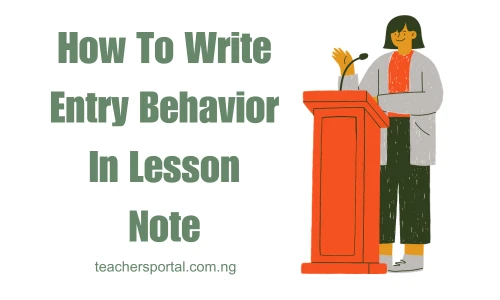In this article, we’ll explore the process of writing entry behavior in a lesson note. Many aspiring teachers, especially student teachers, may have limited knowledge of Entry Behavior and how to incorporate it into lesson planning. If you’re someone seeking to learn about this aspect, then this article is for you. Read through to the end to gain valuable insights.
What Is Entry Behavior In Writing Lesson Note
Definitions
- Entry behavior refers to the prerequisite knowledge, skills, and attitudes that students bring to a new learning task or subject matter. It encompasses the foundation upon which new learning can be built. Identifying and understanding entry behavior is crucial for effective lesson planning, as it allows teachers to tailor their instruction to meet the specific needs and starting points of their students.
- Entry Behavior refers to the fundamental aspect that signifies the learners’ prior knowledge of the subject matter. It involves starting the lesson with an understanding of what the students already know, allowing the teacher or student teacher to progressively transition from known information to unfamiliar content, and introducing new lessons or topics in a structured manner.
- Entry Behavior can be defined as the pre-existing knowledge or ideas that learners have acquired before the commencement of a lesson. It specifically pertains to the understanding or information already known by the learners that is relevant to the upcoming topic being taught. This concept emphasizes the connection between prior knowledge and the subject matter about to be introduced in the educational context.
- Entry Behavior encompasses the knowledge, skills, attitudes, and experiences that students bring to the learning situation. It includes elements such as prior learning, personal beliefs, cultural background, and various factors that influence how a student approaches and engages with new material. Essentially, Entry Behavior recognizes the diverse aspects of a student’s background that shape their readiness and perspective when encountering new educational content.
From the above definitions, we can, however, define Entry Behavior as the knowledge, experience, or skill that a learner may have acquired from their family, household, area, town, community, or society. It encapsulates the understanding and abilities that learners bring with them, shaped by their immediate environment and social context, influencing their readiness and approach to learning in a given educational setting.
Entry Behaviour is mostly written before Instructional Materials or Set Induction. The Entry Behaviour is a crucial aspect of a teacher’s lesson note because it signifies the learners’ prior knowledge of the subject.
How To Write Entry Behavior in Lesson Note (Examples)
When you’re writing about Entry Behavior in a lesson note, think about what students already know. For example, if you’re teaching about “Money”, you can say:
“Students are already familiar with using money to buy things.” They might not know the formal definition of money yet, but they’ve seen and used it before the lesson begins.
In simpler terms, Entry Behavior is about recognizing what students already understand or have experienced before diving into a new lesson. It helps teachers build on what students already know to make learning easier and more relatable.
More Examples:
For example, if you’re teaching about the “Reproductive System,” you can include in your lesson note: “The students have observed animals giving birth to their young ones, especially hens and goats.”
Example 3: If you’re teaching about the “Respiratory System,” you can note in your lesson: “The students have been breathing in and out, experiencing the air previously.”
Example 4: If you’re teaching about the “Circulatory System,” you can include in your lesson note: “The students have heard about circulation and have also seen veins, hearts, and arteries as organs of blood circulation.”
Example 5: If you’re teaching about “Latitude and Longitude,” you can mention in your lesson note: “Students are already familiar with the four cardinal points from their junior class, or they have already encountered Latitude and Longitude in their Geography class.”
Key Aspects Of Entry Behavior
- Prior Knowledge: This involves the knowledge and understanding that students have acquired through previous experiences, education, or exposure to the topic.
- Skills: This refers to the specific skills that students have developed and can apply to the learning task, such as problem-solving, communication, or manipulation of tools or materials.
- Attitudes: This encompasses the dispositions and beliefs that students hold towards the subject matter or learning process. It includes their motivation, interest, and openness to new ideas.
Benefits of Assessing Entry Behavior
- Tailored Instruction: Understanding entry behavior allows teachers to differentiate their instruction and provide support to students based on their individual needs.
- Effective Learning: By building upon students’ prior knowledge and skills, teachers can create more meaningful and engaging learning experiences.
- Identifying Gaps: Assessing entry behavior can reveal gaps in students’ understanding or missing skills, allowing teachers to address these areas early on.
- Promoting Engagement: When students feel connected to the material and see how it relates to their existing knowledge, they are more likely to be engaged and motivated to learn.
- Guiding Lesson Planning: Entry behavior serves as a guide for lesson planning, ensuring that the content and activities are appropriate for the students’ level of understanding.
BY ISRAEL UCHENNA
